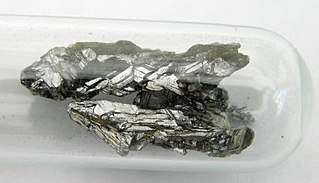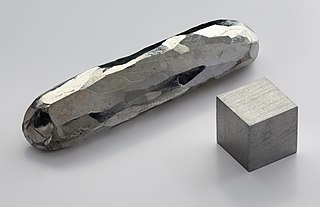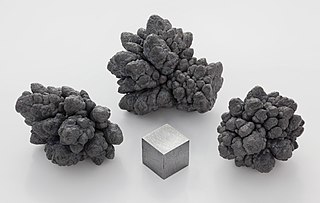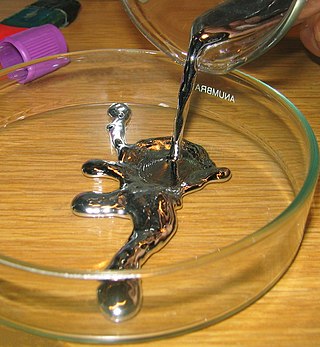Related Research Articles

Arsenic is a chemical element; it has symbol As and atomic number 33. Arsenic occurs in many minerals, usually in combination with sulfur and metals, but also as a pure elemental crystal. Arsenic is a notoriously toxic metalloid. It has various allotropes, but only the grey form, which has a metallic appearance, is important to industry.

Cadmium is a chemical element; it has symbol Cd and atomic number 48. This soft, silvery-white metal is chemically similar to the two other stable metals in group 12, zinc and mercury. Like zinc, it demonstrates oxidation state +2 in most of its compounds, and like mercury, it has a lower melting point than the transition metals in groups 3 through 11. Cadmium and its congeners in group 12 are often not considered transition metals, in that they do not have partly filled d or f electron shells in the elemental or common oxidation states. The average concentration of cadmium in Earth's crust is between 0.1 and 0.5 parts per million (ppm). It was discovered in 1817 simultaneously by Stromeyer and Hermann, both in Germany, as an impurity in zinc carbonate.

Lead is a chemical element; it has symbol Pb and atomic number 82. It is a heavy metal that is denser than most common materials. Lead is soft and malleable, and also has a relatively low melting point. When freshly cut, lead is a shiny gray with a hint of blue. It tarnishes to a dull gray color when exposed to air. Lead has the highest atomic number of any stable element and three of its isotopes are endpoints of major nuclear decay chains of heavier elements. Lead is toxic, even in small amounts, especially to children.

A toxic heavy metal is any relatively dense metal or metalloid that is noted for its potential toxicity, especially in environmental contexts. The term has particular application to cadmium, mercury and lead, all of which appear in the World Health Organization's list of 10 chemicals of major public concern. Other examples include manganese, chromium, cobalt, nickel, copper, zinc, silver, antimony and thallium.
Bioaccumulation is the gradual accumulation of substances, such as pesticides or other chemicals, in an organism. Bioaccumulation occurs when an organism absorbs a substance faster than it can be lost or eliminated by catabolism and excretion. Thus, the longer the biological half-life of a toxic substance, the greater the risk of chronic poisoning, even if environmental levels of the toxin are not very high. Bioaccumulation, for example in fish, can be predicted by models. Hypothesis for molecular size cutoff criteria for use as bioaccumulation potential indicators are not supported by data. Biotransformation can strongly modify bioaccumulation of chemicals in an organism.

Arsenic poisoning is a medical condition that occurs due to elevated levels of arsenic in the body. If arsenic poisoning occurs over a brief period of time, symptoms may include vomiting, abdominal pain, encephalopathy, and watery diarrhea that contains blood. Long-term exposure can result in thickening of the skin, darker skin, abdominal pain, diarrhea, heart disease, numbness, and cancer.

Dimercaprol, also called British anti-Lewisite (BAL), is a medication used to treat acute poisoning by arsenic, mercury, gold, and lead. It may also be used for antimony, thallium, or bismuth poisoning, although the evidence for those uses is not very strong. It is given by injection into a muscle.

Methylmercury (sometimes methyl mercury) is an organometallic cation with the formula [CH3Hg]+. It is the simplest organomercury compound. Methylmercury is extremely toxic, and its derivatives are the major source of organic mercury for humans. It is a bioaccumulative environmental toxicant with a 50-day half-life.
Cadmium is a naturally occurring toxic metal with common exposure in industrial workplaces, plant soils, and from smoking. Due to its low permissible exposure in humans, overexposure may occur even in situations where only trace quantities of cadmium are found. Cadmium is used extensively in electroplating, although the nature of the operation does not generally lead to overexposure. Cadmium is also found in some industrial paints and may represent a hazard when sprayed. Operations involving removal of cadmium paints by scraping or blasting may pose a significant hazard. The primary use of cadmium is in the manufacturing of NiCd rechargeable batteries. The primary source for cadmium is as a byproduct of refining zinc metal. Exposures to cadmium are addressed in specific standards for the general industry, shipyard employment, the construction industry, and the agricultural industry.
The arsenate is an ion with the chemical formula AsO3−4. Bonding in arsenate consists of a central arsenic atom, with oxidation state +5, double bonded to one oxygen atom and single bonded to a further three oxygen atoms. The four oxygen atoms orient around the arsenic atom in a tetrahedral geometry. Resonance disperses the ion's −3 charge across all four oxygen atoms.

Soil contamination, soil pollution, or land pollution as a part of land degradation is caused by the presence of xenobiotic (human-made) chemicals or other alteration in the natural soil environment. It is typically caused by industrial activity, agricultural chemicals or improper disposal of waste. The most common chemicals involved are petroleum hydrocarbons, polynuclear aromatic hydrocarbons, solvents, pesticides, lead, and other heavy metals. Contamination is correlated with the degree of industrialization and intensity of chemical substance. The concern over soil contamination stems primarily from health risks, from direct contact with the contaminated soil, vapour from the contaminants, or from secondary contamination of water supplies within and underlying the soil. Mapping of contaminated soil sites and the resulting clean ups are time-consuming and expensive tasks, and require expertise in geology, hydrology, chemistry, computer modelling, and GIS in Environmental Contamination, as well as an appreciation of the history of industrial chemistry.

Metal toxicity or metal poisoning is the toxic effect of certain metals in certain forms and doses on life. Some metals are toxic when they form poisonous soluble compounds. Certain metals have no biological role, i.e. are not essential minerals, or are toxic when in a certain form. In the case of lead, any measurable amount may have negative health effects. It is often thought that only heavy metals can be toxic, but lighter metals such as beryllium and lithium may also be in certain circumstances. Not all heavy metals are particularly toxic, and some are essential, such as iron. The definition may also include trace elements when abnormally high doses may be toxic. An option for treatment of metal poisoning may be chelation therapy, a technique involving the administration of chelation agents to remove metals from the body.

Environmental toxicology is a multidisciplinary field of science concerned with the study of the harmful effects of various chemical, biological and physical agents on living organisms. Ecotoxicology is a subdiscipline of environmental toxicology concerned with studying the harmful effects of toxicants at the population and ecosystem levels.

Mercury is a chemical element; it has symbol Hg and atomic number 80. It is also known as quicksilver and was formerly named hydrargyrum from the Greek words hydor (water) and argyros (silver). A heavy, silvery d-block element, mercury is the only metallic element that is known to be liquid at standard temperature and pressure; the only other element that is liquid under these conditions is the halogen bromine, though metals such as caesium, gallium, and rubidium melt just above room temperature.

The presence of mercury in fish is a health concern for people who eat them, especially for women who are or may become pregnant, nursing mothers, and young children. Fish and shellfish concentrate mercury in their bodies, often in the form of methylmercury, a highly toxic organomercury compound. This element is known to bioaccumulate in humans, so bioaccumulation in seafood carries over into human populations, where it can result in mercury poisoning. Mercury is dangerous to both natural ecosystems and humans because it is a metal known to be highly toxic, especially due to its neurotoxic ability to damage the central nervous system.
In epidemiology, environmental diseases are diseases that can be directly attributed to environmental factors. Apart from the true monogenic genetic disorders, which are rare, environment is a major determinant of the development of disease. Diet, exposure to toxins, pathogens, radiation, and chemicals found in almost all personal care products and household cleaners, stress, racism, and physical and mental abuse are causes of a large segment of non-hereditary disease. If a disease process is concluded to be the result of a combination of genetic and environmental factor influences, its etiological origin can be referred to as having a multifactorial pattern.

Environmental effects of mining can occur at local, regional, and global scales through direct and indirect mining practices. Mining can cause erosion, sinkholes, loss of biodiversity, or the contamination of soil, groundwater, and surface water by chemicals emitted from mining processes. These processes also affect the atmosphere through carbon emissions which contributes to climate change. Some mining methods may have such significant environmental and public health effects that mining companies in some countries are required to follow strict environmental and rehabilitation codes to ensure that the mined area returns to its original state. Mining can provide various advantages to societies, yet it can also spark conflicts, particularly regarding land use both above and below the surface.

Groundwater pollution occurs when pollutants are released to the ground and make their way into groundwater. This type of water pollution can also occur naturally due to the presence of a minor and unwanted constituent, contaminant, or impurity in the groundwater, in which case it is more likely referred to as contamination rather than pollution. Groundwater pollution can occur from on-site sanitation systems, landfill leachate, effluent from wastewater treatment plants, leaking sewers, petrol filling stations, hydraulic fracturing (fracking) or from over application of fertilizers in agriculture. Pollution can also occur from naturally occurring contaminants, such as arsenic or fluoride. Using polluted groundwater causes hazards to public health through poisoning or the spread of disease.

The lead cycle is the biogeochemical cycle of lead through the atmosphere, lithosphere, biosphere, and hydrosphere, which has been influenced by anthropogenic activities.

Legacy pollution or legacy pollutants are persistent materials in the environment that were created through a polluting industry or process that have polluting effects after the process has finished. Frequently these include persistent organic pollutants, heavy metals or other chemicals residual in the environment long after the industrial or extraction processes that produced them. Often these are chemicals produced by industry and polluted before there was widespread awareness of the toxic effects of the pollutants, and subsequently regulated or banned. Notable legacy pollutants include mercury, PCBs, Dioxins and other chemicals that are widespread health and environmental effects. Sites for legacy pollutants include mining sites, industrial parks, waterways contaminated by industry, and other dump sites.
References
- ↑ "Jerome Nriagu – Faculty Profiles – U-M School of Public Health". sph-webprod.sph.umich.edu. Retrieved 2023-06-19.
- ↑ "Jerome Nriagu, PhD, DSc | Faculty Profiles | U-M School of Public Health". sph.umich.edu.
- ↑ "Jerome Nriagu". scholar.google.com.
- ↑ "The first 36 years of Science of the Total Environment (STOTEN)".
- ↑ "Encyclopedia of Environmental Health – 2nd Edition". www.elsevier.com.
- ↑ "Book Series: Topics in Environmental Health". www.elsevier.com.
- ↑ "Jerome Nriagu – Faculty Profiles – U-M School of Public Health". sph-webprod.sph.umich.edu. Retrieved 2023-06-30.
- ↑ "CURRICULUM VITAE – JEROME NRIAGU". deepblue.lib.umich.edu. hdl:2027.42/163513.
- 1 2 "Jerome Nriagu Awarded Honorary Doctor of Science Degree by University of Alberta" (PDF).
- ↑ Nriagu, Jerome O.; Pacyna, Jozef M. (May 17, 1988). "Quantitative assessment of worldwide contamination of air, water and soils by trace metals". Nature. 333 (6169): 134–139. Bibcode:1988Natur.333..134N. doi:10.1038/333134a0. PMID 3285219. S2CID 4262601 – via www.nature.com.
- ↑ Nriagu, Jerome O. (March 17, 1989). "A global assessment of natural sources of atmospheric trace metals". Nature. 338 (6210): 47–49. Bibcode:1989Natur.338...47N. doi:10.1038/338047a0. S2CID 26898308 – via www.nature.com.
- ↑ Nriagu, Jerome O.; Coker, Robert D.; Barrie, Len A. (January 17, 1991). "Origin of sulphur in Canadian Arctic haze from isotope measurements". Nature. 349 (6305): 142–145. Bibcode:1991Natur.349..142N. doi:10.1038/349142a0. S2CID 4234896 – via www.nature.com.
- ↑ Nriagu, Jerome O.; Glooschenko, Walter A. (1992). "Isotopic composition of sulfur in mosses across Canada". Environmental Science & Technology. 26 (1): 85–89. Bibcode:1992EnST...26...85N. doi:10.1021/es00025a007.
- ↑ Rankin, C. W.; Nriagu, J. O.; Aggarwal, J. K.; Arowolo, T. A.; Adebayo, K.; Flegal, A. R. (2005). "Lead Contamination in Cocoa and Cocoa Products: Isotopic Evidence of Global Contamination". Environmental Health Perspectives. 113 (10): 1344–1348. doi:10.1289/ehp.8009. PMC 1281277 . PMID 16203244.
- ↑ Flegal, A. R.; Nriagu, J. O.; Niemeyer, S.; Coale, K. H. (June 17, 1989). "Isotopic tracers of lead contamination in the Great Lakes". Nature. 339 (6224): 455–458. Bibcode:1989Natur.339..455F. doi:10.1038/339455a0. S2CID 4317214 – via www.nature.com.
- ↑ Nriagu, Jerome O.; Wong, Henry K. T. (November 1, 1989). "Dynamics of particulate trace metals in the lakes of Kejimkujik National Park, Nova Scotia, Canada". Science of the Total Environment. 87–88: 315–328. Bibcode:1989ScTEn..87..315N. doi:10.1016/0048-9697(89)90245-3 – via ScienceDirect.
- ↑ Wilford, John Noble (March 17, 1983). "ROMAN EMPIRE'S FALL IS LINKED WITH GOUT AND LEAD POISONING (Published 1983)" – via NYTimes.com.
- ↑ Bernstein, Lenny. "Lead poisoning and the fall of Rome" – via www.washingtonpost.com.
- ↑ Nriagu, J. O. (1983). "Saturnine Gout among Roman Aristocrats — Did Lead Poisoning Contribute to the Fall of the Empire?". The New England Journal of Medicine. 308 (11): 660–3. doi:10.1056/NEJM198303173081123. PMID 6338384.
- ↑ Bhowmick, Subhamoy; Halder, Dipti; Nriagu, Jerome; Guha Mazumder, Debendra Nath; Roman-Ross, Gabriela; Chatterjee, Debashis; Iglesias, Mònica (2014). "Speciation of Arsenic in Saliva Samples from a Population of West Bengal, India". Environmental Science & Technology. 48 (12): 6973–6980. Bibcode:2014EnST...48.6973B. doi:10.1021/es4056142. PMID 24857783.
- ↑ Bernstam, Luda; Lan, Cheng-Hang; Lee, Janice; Nriagu, Jerome O. (July 1, 2002). "Effects of Arsenic on Human Keratinocytes: Morphological, Physiological, and Precursor Incorporation Studies". Environmental Research. 89 (3): 220–235. Bibcode:2002ER.....89..220B. doi:10.1006/enrs.2002.4367. PMID 12176006 – via ScienceDirect.
- ↑ Halder, Dipti; Biswas, Ashis; Šlejkovec, Zdenka; Chatterjee, Debashis; Nriagu, Jerome; Jacks, Gunnar; Bhattacharya, Prosun (November 1, 2014). "Arsenic species in raw and cooked rice: Implications for human health in rural Bengal". Science of the Total Environment. 497–498: 200–208. Bibcode:2014ScTEn.497..200H. doi:10.1016/j.scitotenv.2014.07.075. PMID 25129156 – via ScienceDirect.
- ↑ Erdenebayar, Erdenechimeg; Santos, Keilah Dos; Edwards, Alexjandria; Dugersuren, Nyam-Osor; Ochir, Chimedsuren; Nriagu, Jerome (2019). "Environmental injustice and childhood lead exposure in peri-urban (ger) areas of Darkhan and Erdenet, Mongolia". BMC Public Health. 19 (1): 163. doi: 10.1186/s12889-019-6486-x . PMC 6367793 . PMID 30732589. S2CID 64322419.
- ↑ Nriagu, J.; Oleru, N. T.; Cudjoe, C.; Chine, A. (1997). "Lead poisoning of children in Africa, III. Kaduna, Nigeria". The Science of the Total Environment. 197 (1–3): 13–9. Bibcode:1997ScTEn.197...13N. doi:10.1016/s0048-9697(96)05408-3. PMID 9151435.
- ↑ Tsai, J.J.; Tsai, A.C.; Nriagu, J.O.; Ghosh, M.; Gong, M. (2006). "Risk factors for respiratory symptoms and asthma in the residential environment of 5th grade school children in Taipei, Taiwan". Journal of Asthma. 43 (5): 355–361. doi:10.1080/02770900600705326. PMID 16801139. S2CID 42988056.
- ↑ Nriagu, Jerome O. (June 30, 1992). "Toxic metal pollution in Africa". Science of the Total Environment. 121: 1–37. Bibcode:1992ScTEn.121....1N. doi:10.1016/0048-9697(92)90304-B. PMID 1439723 – via ScienceDirect.
- ↑ "Mercury pollution from the past mining of gold and silver in the Americas" (PDF).
- ↑ Nriagu, Jerome O.; Pfeiffer, Wolfgang C.; Malm, Olaf; de Souza, CRISTINA M. MAGALHAES; Mierle, Gregory (April 17, 1992). "Mercury pollution in Brazil". Nature. 356 (6368): 389. Bibcode:1992Natur.356..389N. doi: 10.1038/356389a0 . PMID 1557116. S2CID 26442233.
- ↑ "Mercury Concentrations in Water, Sediment, and Biota from Lake Victoria, East Africa".
- ↑ Nriagu, J. O.; Bhattacharya, P.; Mukherjee, A. B.; Bundschuh, J.; Zevenhoven, R.; Loeppert, R. H. (January 1, 2007). Arsenic in soil and groundwater: an overview. Vol. 9. Elsevier. pp. 3–60 – via ScienceDirect.
- ↑ "Past Award Winners | The Royal Society of Canada". rsc-src.ca.
- ↑ "Renowned environmental scientist lectures March 30".
- ↑ "ICHMET's Lifetime Achievement Award to Department Director Jozef M. Pacyna". NILU. September 27, 2012.